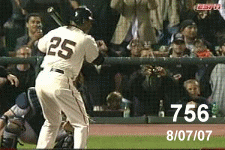I've got this from baseball-fever.com in justthefact's post
quote:
The Need To Clear the Hips by Dr. Michael Yessis is President of Sports Training
With the start of the U.S. Open today many golfers and golf fans will be watching their favorite pros. Most of them will be watching to see how far the ball goes, where it lands in the fairway, rough or on the green. Few however, will be looking closely, with an analytical mind, to how they execute the swing. For those of you who do I recommend that you look closely at how well they clear the hips. This is an action (really two actions) that they all execute — some much better than others well. The key elements to watch for are explained in the following article that I wrote for Senior Golfer.
To have an effective swing it is necessary to clear the hips. This is a recommendation that has little dispute among teaching pros. However, what constitutes clearing the hips, the roles that the hips play and the need for hip action in the total sequence of joint actions that occur in the swing are often misunderstood.
Clearing the hips consists of two major actions. First is weight shift (weight transference) followed by forward hip rotation. For a right handed golfer to execute weight transference, it is necessary to contract the muscles on the right side of the hips to push the hips forward while they remain level to the ground. This action is known as hip joint abduction. The more forcefully you drive the hips forward, the greater is the weight shift and the ensuing power that can be generated for eventual transfer into the hit.
Too much weight shift, however, can be a detriment as it may interfere with the following trunk rotation and arm actions or with balance. But it is generally agreed that weight should be shifted forward and that most of your weight should be on the forward leg during the downswing. This is needed for several very important reasons.
When you shift the weight onto the forward left leg, it then becomes the axis for hip rotation which begins as weight shift ends. When you then rotate the hips with the axis in the left leg, you will get maximum force generated in this action. If you only shift the weight partially so that it is equally distributed between both feet, the axis of rotation becomes your spine (middle of the hips) and the amount of power generated by the hip rotation is halved.
When your weight is over the forward leg, the medial rotator muscles of the left hip joint contract to rotate the entire pelvis forward. As a result, you produce a long hip lever which, in turn, creates more force. This is analogous to using a long club versus a short club. The longer the club (which acts as a lever), the more the force that you can generate.
When your weight is shifted half-way so that the spine is the axis of rotation, the medial rotators of the left and the lateral rotators of the right hip joint contract to rotate the hips. In this case, your right hip rotates forward while the left hip rotates backward. Thus you have a shorter effective lever which is not capable of generating maximum force. In this case, it is half of what can be generated with a full lever hip turn. When your weight is shifted half-way so that the spine is the axis of rotation, the medial rotators of the left and the lateral rotators of the right hip joint contract to rotate the hips. In this case, your right hip rotates forward while the left hip rotates backward. Thus you have a shorter effective lever which is not capable of generating maximum force. In this case, it is half of what can be generated with a full lever hip turn.
Thus, when you have full weight shift (a strong, full hip slide) prior to hip rotation you can create more power. This in turn equals greater distance. If you look at most long ball hitters you will see that they have full weight shift before rotating the hips.
Dr. Michael Yessis is President of Sports Training, Inc. a multi-faceted company specializing in biomechanical/kinesiological analyses, and specialized training and specialized equipment for explosive speed and quickness. Dr. Yessis is Professor Emeritus at California State University, Fullerton. He is a clinical advisor and a member of the editorial board for the American Running Association.
Dr. Yessis received his Ph.D. from the University of Southern California. He was the first to show the relationships between muscular strength and endurance in his research. He taught on the university level for over 35 years in the areas of biomechanics (technique analysis), kinesiology (muscle and joint movements) and exercise science. In addition he was Editor-in-Chief of the Fitness and Sports Review International.
Dr. Yessis is the foremost U.S. expert on Russian training methods He has been to Russia multiple times, worked with their coaches such as Yuri Verkhoshansky, and has translated and published Russian training articles in the Fitness and Sports Review International for over 29 years.
I find it interesting. Seems like it advocates "weight shift BEFORE hip rotation" aka option 1. Thoughts?



